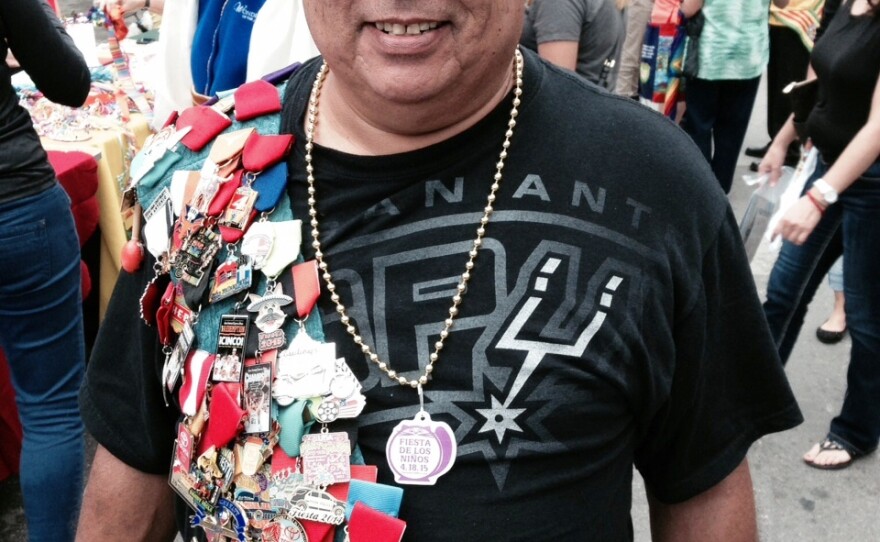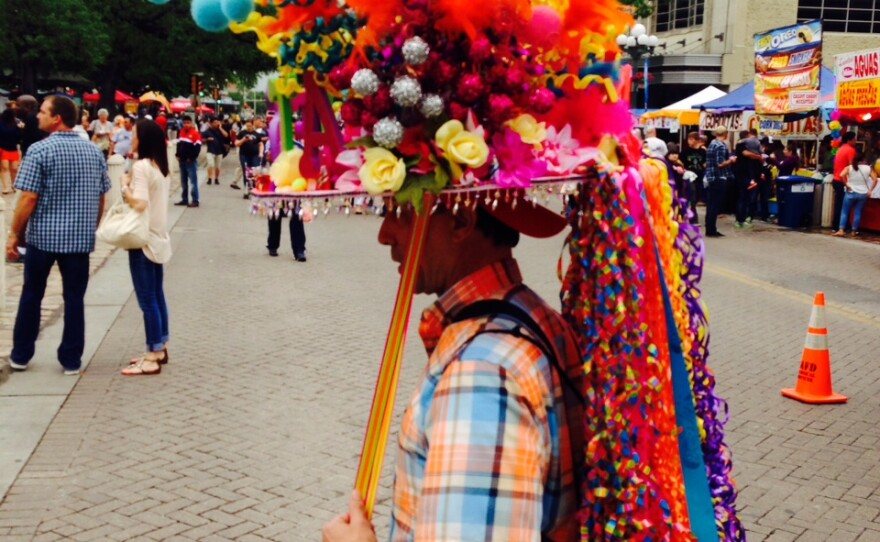Creating, producing and collecting Fiesta medals: It’s one of the odd things about Fiesta that distinguishes it from citywide celebrations any where else.
Rains threaten the first Friday of Fiesta in downtown’s Alamo Plaza. Thousands of people mingle in front of dozens of vendors who have set up a double row of fold-up tables in front of the Menger Hotel. What they’re selling and trading is the entire focus of the opening event called Fiesta Fiesta.
“I’ve been at this for over 20 years!" exclaims Rosa Mendez. "I’m the queen of medals. I collect medals. Normally I get one of these and I cover the whole front of it and the whole back of it.”
She’s talking about her double-sided sash and those medals, the two-to-three-inch square decorative, Fiesta-themed medals produced by people, companies and city departments to honor San Antonio’s biggest celebration. Rosa isn’t alone in her collecting. Several hundred people are here doing the same thing, including Bobby Rodriguez, who’s been collecting for six years.
“How many do you have on?” I asked him.
“Probably over a thousand at least. Together I probably have 6 or 7 thousand. I have two sashes worth.”
So, why do these medals matter to him? What makes one stand out from the next?
“The bling, the design. I like a lot of the ones they make at home that are non-traditional, kind of. Those are my favorite.”
I asked collector Elsa Ramon why San Antonio has this enormous medal-based swap meet.
“Everyone has their own association medal or their representation of their family motto maybe. Or whatever king or queen or princess that they represent. And everybody sells medals or trades medals for profit sometimes.”
Cultural anthropologist Michaele Haynes traces Fiesta medal history back to 1946, when the Texas Cavaliers created little coins to take to hospitalized children.
"They had special coins -- the king’s coin -- and they’re just little half-dollar sized coins. But in 1961, Joske’s department store provided the Cavaliers with a little cardboard piece that had a punch-out in the center where you could insert the coin. And then it apparently had a hole in the top of it where ribbons could be inserted through those. And so you could then hang this around your neck. After 1971 a few other Fiesta organizations started producing Fiesta medals, but it was not a "thing" at all."
"Not a thing" meaning the collection of medals was not then the huge thing it is now. So who made Fiesta medals such a phenomenon? Weirdly, it has a German connection, propelled by someone who wasn’t a San Antonian at all.
“It was Lt. Col. Childers, was stationed at Ft. Sam, and he had always been an avid Volksmarcher in Germany.”
Volksmarching is non-competitive distance-walking.
"This was in 1980," Haynes says. "[Childers] is the instigator of the first military medal that then gets distributed in a public way. And then by the 1990s -- that’s when all kinds of organizations start producing their own medals.”
I asked her, "What are some of the most interesting medals you’ve seen?”
“One sticks out in my memory. They developed a medal that was based on a round, a circular object that one might find in certain areas in the drug store -- all in little packages of course.”
I asked, “This would be something that you would be embarrassed to ask to purchase?”
“Yes! But of course, Cornyation was associated with raising funds for AIDS, for prevention of AIDS. It was a perfect icon to be used for it, and the one that I have has a little flamingo on top of it.”
Cornyation is the irreverent, comical theatrical counterpoint to the Fiesta pomp and pageantry. The Medals history is interwoven with Fiesta Royalty and the social strata of San Antonio society.
She noted the way medal distribution had changed, "Up until recently you did not get one of the special medals from the Queen of the Order of the Alamo unless you knew her."
Which prompted me to ask, with a smirk, “So you’re not like…a medal snob, are you?” She didn't hesitate long before responding.
"Oh yes…I probably am!" she laughed.
Back at Alamo Plaza it rains, then it stops. And the collectors keep coming despite the weather.
Larry Algueseva wears an enormous hat in the shape of a dog -- his dog -- who he’s anointed as the Fiesta Canine Queen.
"She’s always the Fiesta Canine Queen. I have done her medal now for probably ten years."
People come and go at the tables, haggling prices and looking for deals.
"They’re five dollars, and they go towards client services. That’s cheap; you have to admit that!"
"Okay."
And the tradition plays on, with the selection of medals growing every year.
Jack Morgan can be reached at Jack@TPR.org and on Twitter at @JackMorganii.



















